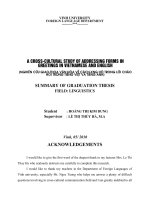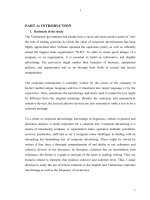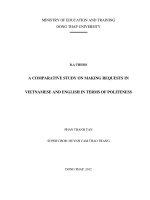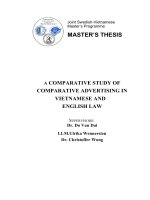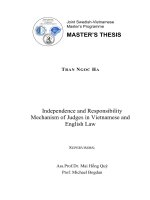- Trang chủ >>
- Luật >>
- Luật dân sự
topic speech acts title making invitations in vietnamese and english informal contexts
Bạn đang xem bản rút gọn của tài liệu. Xem và tải ngay bản đầy đủ của tài liệu tại đây (377.31 KB, 14 trang )
<span class="text_page_counter">Trang 1</span><div class="page_container" data-page="1">
<b>Course title: PragmaticsGROUP: 1</b>
<b>TOPIC: SPEECH ACTS</b>
<b>Title: Making invitations in Vietnamese and Englishinformal contexts </b>
Nguyễn Ngọc Thành Lưu Thị Nhật Minh Tăng Yến Nhi Võ Kim Ngân
</div><span class="text_page_counter">Trang 2</span><div class="page_container" data-page="2"><i><b>4.2. Making invitation in English:...4</b></i>
<i><b>4.3. Making invitation in Vietnamese:...5</b></i>
<i><b>4.4. Comparison between invitations of informal Vietnamese and English situations:...6</b></i>
<b>5. Conclusion...12</b>
<b>6. References...12</b>
</div><span class="text_page_counter">Trang 3</span><div class="page_container" data-page="3"><b>1. Abstract.</b>
This study is an attempt to describe and analyze the realization patterns of the speech act of informal inviting. The study attempts to detect causes for potential differences of the speech act realization strategies during conversations such as Linguistic or pragmatic aspects or even cultural values. In addition, the study aims to highlight some cultural values underlying informal invitations. In this study, throughout real contexts aim to easily compare the diversity in speech acts of invitations culturally in terms of informal. Furthermore, this study attempts to analyze some classification of informal invitations similar to both countries that show the differences in daily speech acts. Finally, divergence in politeness features and social parameters leads to divergent speech act strategies across the relevant cultures and languages.
<b>2. Literature review.</b>
The invitation to take action is an important part of communication as it invites someone to do something. The form and function of the act of saying an invitation changes at some point in English and Vietnamese.
An invitation is frequently conveyed in English as a courteous request.
Vietnamese invites, on the other hand, are clearer. Moreover, Vietnamese invites frequently include the giving of food or drink to the invitee.
Much research has been conducted to discover the expression of invitation in bothlanguages, as well as the similarities and differences between the act of invitation in English and Vietnamese. According to some studies, while there are
differences in language in the form and purpose of invites, there are also numerous similarities. Both English and Vietnamese invitations, for example, frequently include the usage of polite signals to express respect to the invitee.Overall, recognizing the variations and similarities between the act of invitation in English and Vietnamese may help strengthen cross-cultural communication and minimize social misconceptions.
<b>3. Research methodology.</b>
An explanatory qualitative research approach is used to conduct this study. The Qualitative Method focuses on collecting and analyzing words or images more
</div><span class="text_page_counter">Trang 4</span><div class="page_container" data-page="4">than numbers. The Qualitative Method is used in this study because it gives a profound insight into a problem and generates new ideas for the study. Besides, this method addresses the problem logically and indicates the possible results of the study. We use descriptive data in this research to make people understand how the researchers obtained the data and assess the validity of the research. Besides, this research is based on the comparison between English and Vietnamese’s use in making invitations. Therefore, this research helps people distinguish between making invitations in Vietnamese and making invitations in English examples used in different contexts.
<b>4. Analysis</b>
<i><b>4.1. Definition:<small>1</small></b></i>
In order to understand what “making invitation” means, let us look at the meaningof the verb “invite”. As for the Cambridge Dictionary, “invite” means to ask or request someone to go to an event and or do something, or the act of inviting someone.
<i><b>4.2. Making invitation in English:</b></i>
English invitation trends to lead the listeners to the direct content of the speakers. When the invitation is spoken out, the listeners can understand the meaning and what they have to do with the speakers. In general, English invitation is in the form of many basic kinds of sentences: performative sentence, directive sentence, directive sentence with “let’s”, yes/no question, WH- question, and tag question.
- Performative sentence: This is the same point in Vietnamese meaning “mời” that expresses the related action as soon as uttered by the narrator. It usually has formed with: Would you like to invite…” or “... want to invite…”. For example, “I would like to invite you to come to my wedding.”
- Directive sentence: These invitations seem like requests and orders that are often used in a close relationship. Some instances for making invitation by directive sentences are:
+ “Do join me for a coffee.”
<small>1 Cambridge dictionary, accessed March 31, 2023</small>
</div><span class="text_page_counter">Trang 5</span><div class="page_container" data-page="5">+ “Come and meet me at Dalat”
- Directive sentence with “let’s”: This type often appears in friendly
relationships. People use it to invite each other in a close way. In addition, Theseinvitations are suitable for people of the same age or social status. For example, “ Let’s go out to have a couple date”
- Yes/No question: This kind of invitation shows politeness and respect to the listeners in a conversation. For example, “ Shall we have a drink at 6 p.m at Toulejour restaurants?”
- WH-question: WH-question is used in making invitations with the highest frequency. In a close friendship, people use this kind of questions to invite each other with a view to increase friendliness. It makes the listeners feel comfortableand free. For example: Why don’t you take a picnic with us on the weekend? The WH-question often started with “Would you like to?” often appear in making invitations. It is familiar to foreigners and the native speakers.- Tag question: Tag question is rarely used in making invitations. The speaker uses this kind of question to remind or repeat their invitation to the invited people. For example: You will take part in a BBQ party with us tonight, won’t you?
<i><b>4.3. Making invitation in Vietnamese:</b></i>
In our everyday social lives, we perform a number of linguistic actions, including inviting, making invites, and denying invitations. An invitation is regarded a polite request from a pragmatic and linguistic action standpoint. In Vietnamese, invitation denotes the invitee’s respectful, cordial, polite, and hospitable. The invitation demonstrates the speaker's favorable attitude toward maintaining a good connection with the listener (the invitee), and it is also an act to honor the invitee's face.
- Performative sentence: In general, the inviter will describe his or her invitation with saying the word “mời”. In performative divided into 2 types:
+ Performative sentence without subject: “ Mời ông ngồi xuống đây nghỉ mệt ạ”
</div><span class="text_page_counter">Trang 6</span><div class="page_container" data-page="6">+ Performative sentence with subject: “ Nay sinh nhật thằng Hiếu, tôi xin mời cả nhà sang chung vui”.
- Declarative sentence: In this sentence form, the inviter makes his invitation in the form of a narrative sentence. For exampple, thấy bố đi làm về, cu Tí bưng nước chạy ra đưa cho bố: “Bố uống cho đỡ mệt”.
- Imperative sentence: In this sentence form, the invitation follows the form of an imperative, especially in Vietnamese, often used with the word “đi”. For example,“Mọi người ăn đi”
- Interrogative sentence: In this sentence form, the inviter will use interrogative sentences or indirectly make an invitation by inviting words showing a friendly and hospitable attitude, wanting to welcome the invitee. For example, “Cu tí, sao dạo này không ghé bác chơi? Nay nhà bác nấu cỗ đấy”.
<i><b>4.4. Comparison between invitations of informal Vietnamese and English situations:</b></i>
Making invitations between Vietnamese and English context has both similarities and differences. In terms of similarities, there are several points.
The first point of similarity between these two languages is that invitation maintains the performative verb “invite” in English and “mời" in Vietnamese if it is under the form of a performative sentence. Generally, people often use it to give their invitation directly.
</div><span class="text_page_counter">Trang 7</span><div class="page_container" data-page="7">Anh: Chào em, cuối tuần này anh có dự định tổ chức một buổi tiệc BBQ tại nhà, em có muốn đến tham gia không?
Bảo: Wow, nghe thật thú vị. Thời gian nào anh?
Anh: Tối thứ 7 này, từ 6 giờ đến khoảng 9 giờ tối, em có thể tham gia được không?
Smith: It’s about the new project that we’re working on.
<small>3 Dialogue 15 - Formal greetings and invitations - Learn English Free. (2020, June 3). Learn ENGLISH.</small>
<small>4 A. (2022, August 29). 5 Contoh Dialog Tentang Invitation 2 Orang Dalam Bahasa Inggris. Superonlline.</small>
</div><span class="text_page_counter">Trang 8</span><div class="page_container" data-page="8">John: I’m sorry, but I can’t make it. I have other plans. Smith: That’s too bad. Well, I will rearrange the meeting.
Finally, both languages often suggest a specific time and place to meet up and make plans together. In both Vietnamese and English, the speaker often asks for the listener's availability or preference before making a plan together.
Jame: Hey, are you free after work today?
Hanna: Yeah, I don't have any plans. Why do you ask?
Jame: I was thinking of grabbing drinks with some coworkers at The Local later. Do you want to come along?
Hanna: Sure, that sounds like fun. What time were you thinking?
Jame: I was thinking we could leave the office around 8p.m and head over there.Hanna: Okay, that works for me.
</div><span class="text_page_counter">Trang 9</span><div class="page_container" data-page="9">Thúy: Cũng được, thế chúng ta gặp nhau lúc 2 giờ chiều tại cửa hàng Zara được không?
Ly: Shopping xong thì ăn tối ở đó ln nhé.Thúy: Được thơi.
Second, Vietnamese also tend to use more polite language in their invitations thanEnglish speakers do. This is because Vietnamese culture places a great emphasis on social hierarchy and shows respect for others. For example, a Vietnamese invitation might begin with "Xin mời anh/chị đến dự" (Please come and join us), while an English invitation might simply say "Come join us!".
<small>6 Beare, K. (2019, November 4). Making Invitations. ThoughtCo.</small>
<small>7 Listening: Making an Invitation Dialog | Sederet.com. (n.d.).</small>
</div><span class="text_page_counter">Trang 10</span><div class="page_container" data-page="10">James: John, I have an invitation for you.John: Oh, from whom?
James: From me. My wife would love it if you come to our house next Sunday.John: To your house? But this isn’t your address.
James: We’ve moved to a new house since last week.
John: Oh, congratulations! Why didn’t you say so? Has anything settled? If you need anything, I would love to help.
James: Almost. We’re still moving some stuff. You only have to come on Sunday. We’re having a simple buffet to show our gratitude for the new house.John: All right, I’ll see you Sunday!
Ngọc: Chắc chắn, em sẽ đến đúng giờ ạ. Cảm ơn chị đã mời em ạ.
Third, in Vietnamese culture, it is common to invite someone to join a group of friends or family members, rather than inviting them individually. For example, a typical Vietnamese invitation might be "Mình đi chơi với nhóm bạn vào cuối tuầnnày nhé?" (Let's go out with a group of friends this weekend, okay?), while an English invitation might be more individualistic, such as "Do you want to hang out with me this weekend?"
</div><span class="text_page_counter">Trang 11</span><div class="page_container" data-page="11">Iris: I am good, too. Hey, I am getting married next month and I wanted to invite you to my wedding.
Jane: Really? I’m happy to hear that. And yes, I would love to come. Iris: The wedding will be held on Saturday, October 10th at 3pm. Jane: Perfect! I’ll be there. Iris: Great! I am looking forward to seeing you.
A: Vậy là tốt rồi, em cám ơn anh nhiều nhé.
Fourth, in Vietnamese, there are different pronouns used to address people of different ages or social status. This means that the pronoun used to invite someone may vary depending on the relationship between the two people. In English, however, there is generally only one form of address used for everyone, regardless of age or social status.
</div><span class="text_page_counter">Trang 12</span><div class="page_container" data-page="12">A: Chào em, hơm nay có buổi biểu diễn ca nhạc rất hay tại nhà hát thành phố, em có muốn đi cùng anh khơng?
B: Thật sao? Sếp mời em đi hả, em thích lắm đấy ạ. Nhưng Sếp có vé khơng ạ? Và buổi biểu diễn vào lúc nào vậy ạ?
A: Có em, anh đã đặt sẵn hai vé rồi. Buổi biểu diễn diễn ra vào lúc 8 giờ tối.B: Tuyệt quá! Em sẽ đi cùng anh ạ. Cám ơn anh đã mời em.
A: Khơng có gì đâu em. Chúng ta có thể hẹn gặp nhau trước cửa nhà hát vào lúc 7giờ 30 phút để vào cùng nhau.
B: Vâng. Em sẽ đến đúng giờ ạ.A: Ok em, hẹn gặp em vào tối nay.
Fifth, nonverbal communication, such as facial expressions and gestures, can playan important role in making invitations in both Vietnamese and English. However, the specific cues used may vary between cultures. For example, in Vietnamese culture, it is common to nod the head slightly downwards as a sign ofrespect when making an invitation.
Dika: Leo, are you free this Saturday?
Leo: Yeah, I think so. Why? Dika: I would like to invite you to my exhibition thisSaturday.
Leo: Oh, you have your own exhibition? Dika: Yes.
Leo: What time does the exhibition start?
Dika: I’ll prepare at noon but maybe you can come over at five or six. Leo: OK then, I’ll take my little brother, too. Thank you for inviting me, Dika. Dika: Yeah, glad you can come over, too.
<small>9 Nailufar, N. N. (2020, November 18). Contoh Dialog Inviting Someone Halaman all - Kompas.com. KOMPAS.com.</small>
</div><span class="text_page_counter">Trang 13</span><div class="page_container" data-page="13">Linh: Mình sẽ cố gắng tham gia. Cậu dự định tổ chức khi nào và ở đâu vậy?Finally, English speakers may use humor or sarcasm to make invitations more lighthearted or playful. In Vietnamese, humor is also used, but it may be more subtle and indirect.
<small>10 Dialogue 14 - Informal greetings and invitations - Learn English Free. (2020, June 3). Learn ENGLISH.</small>
</div><span class="text_page_counter">Trang 14</span><div class="page_container" data-page="14">- My Lingua Academy. October 27, 2022. Making, Accepting and Refusing Invitations. Accessed March 27, 2023 from
TaiLieu.VN. (n.d.). Tìm hiểu lời mời trong giao tiếp tiếng Việt.
A. (2019, February 19). 2 Simple, Friendly Ways to Invite Someone in English. Speak Confident English. Dialogue 15 - Formal greetings and invitations - Learn English Free. (2020, June 3). Learn ENGLISH. A. (2022, August 29). 5 Contoh Dialog Tentang Invitation 2 Orang Dalam Bahasa Inggris. Superonlline. Beare, K. (2019, November 4). Making Invitations. ThoughtCo. Listening: Making an Invitation Dialog | Sederet.com. (n.d.). A. (2022d, August 29). 5 Contoh Dialog Tentang Invitation 2 Orang Dalam Bahasa Inggris. Superonlline. Nailufar, N. N. (2020, November 18). Contoh Dialog Inviting Someone Halaman all - Kompas.com. KOMPAS.com.
Dialogue 14 Informal greetings and invitations Learn English Free. (2020, June 3). Learn ENGLISH.


